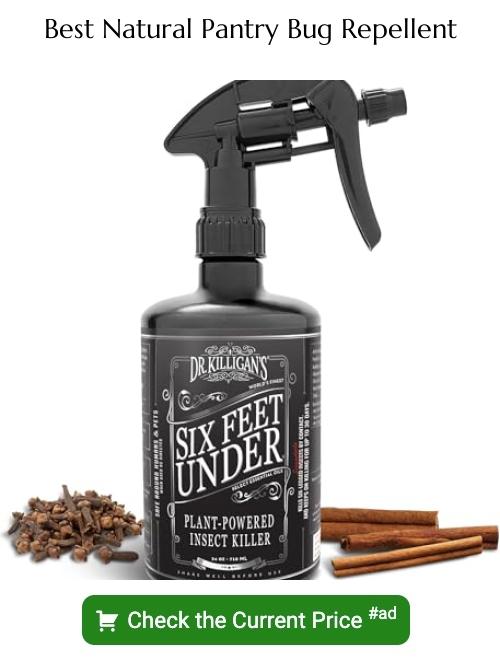Last updated on
Discover natural, effective strategies to eliminate pantry bugs and prevent future infestations.
Pantry bugs, also known as pantry pests, are a common household nuisance. These unwelcome guests can infiltrate your food supply, making meals less than appetizing.
Fortunately, there are natural methods to eradicate these pests. By following a few simple steps, such as maintaining cleanliness, using natural repellents, and storing food properly, you can effectively eliminate pantry bugs.
This article will provide a comprehensive guide on how to get rid of pantry bugs naturally, ensuring your kitchen remains pest-free. The solutions offered here are easy to implement, cost-effective, and do not involve harmful chemicals, making them safe for households with children and pets.
So, if you’re ready to reclaim your pantry from these pesky invaders, continue reading for a detailed, step-by-step guide.
Key takeaways:
- Pantry bug types: weevils, flour beetles, meal moths, grain beetles, cigarette/drugstore beetles.
- Steps to get rid of pantry bugs naturally: clean, use bay leaves, airtight containers, diatomaceous earth, essential oils.
- DIY natural pantry bug spray: distilled water, witch hazel, essential oils.
- Importance of cleaning expired spices for bug prevention.
- Organize pantry strategically, use bay leaves, clean spills, inspect groceries, seal cracks.
Identifying Common Pantry Bugs
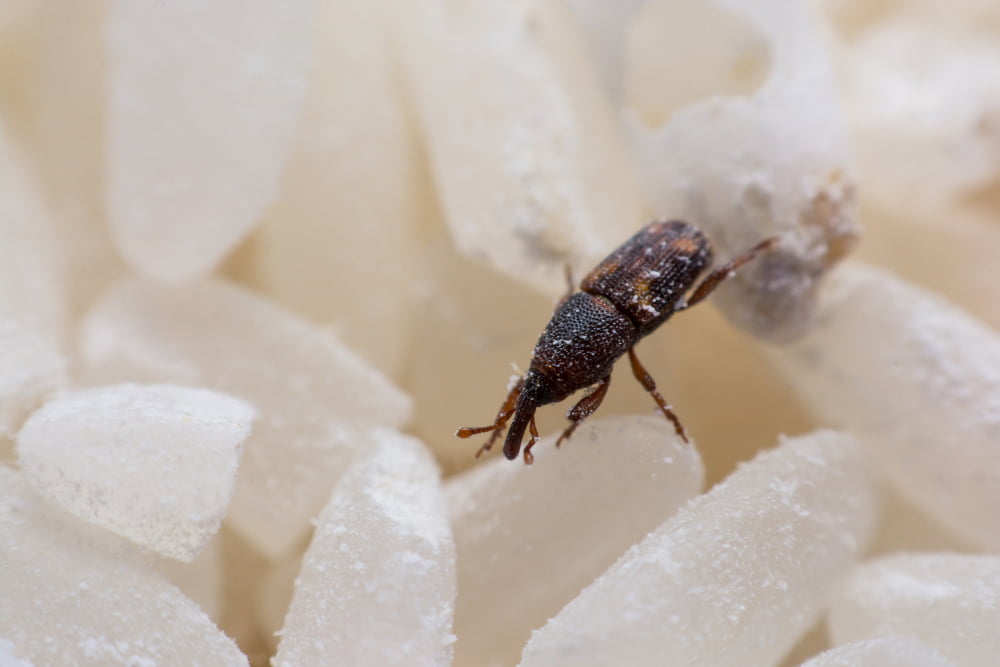
There exists a wide range of pantry bugs or pests. Though they come in different shapes and IDs, most hold common traits. They’re small, and you’ll likely spot them close to food sources.
1. Weevils: Recognizable by their elongated snouts, these critters generally invade grain products and rice. They’re small, brown, and their larvae bore directly into food items.
2. Flour Beetles: Attracted to, as their name suggests, flour, but also grains and spices. They range in color from reddish-brown to nearly black.
3. Indian Meal Moths: The adults have a distinctive reddish-brown wing tip color, while the larvae are off-white with brown heads. They have an affinity for dried fruit, pet food, and certain grains.
4. Sawtoothed Grain Beetles: These flat, brown bugs are tiny and like to hide in crevices and cracks, but you’ll mostly find them in processed food packages like cereals, dry pasta, and chocolate.
5. Cigarette and Drugstore Beetles: Small and brown, they prefer dried plants, spices, and tobacco; they are prone to causing considerable damage to stored food.
Knowing how to identify these pests can prove pivotal in understanding how to best implement natural control and prevention methods. Now, let’s dive into these methods.
Steps for Getting Rid of Pantry Bugs Naturally

Begin by emptying the pantry completely. Wipe down all the shelves, corners, nooks and crannies with white vinegar. The acidic nature of vinegar helps kill the bugs and their eggs. Put everything outside in sun for a couple of hours. This helps kill any remaining bugs or larvae.
Bay leaves have a strong scent that bugs dislike. Tuck bay leaves in the corners of your shelves, or tape them to the bottoms of containers to deter pests.
Store all food items in airtight glass or metal containers. This prevents re-infestation by making it difficult for bugs to reach the food.
Sprinkle Diatomaceous Earth, a non-toxic powder made of fossilized aquatic organisms, in your pantry. Its sharp particles pierce the exoskeleton of insects causing dehydration and death.
Finally, use essential oils like peppermint or eucalyptus as a natural bug repellent. Mix a few drops with water and spray lightly on shelves before placing the food items back.
DIY Natural Pantry Bug Spray: Ingredients and Instructions

You’ll need:
- 1. Distilled water
- 2. Witch hazel
- 3. Essential oils (Clove, Peppermint, or Tea Tree)
- 4. Glass spray bottle
Here’s how to prepare:
- i. Fill half of your spray bottle with distilled water.
- ii. Add equal parts of witch hazel, fill until the bottle is nearly full, leaving a little space for your essential oils.
- iii. Add 10-15 drops of each selected essential oil.
- iv. Shake before every use, and spray lightly on pantry shelves, cabinets, or anywhere bugs are spotted.
These essential oils are potent because they disrupt the pheromones that bugs use to communicate, making your pantry a less attractive home for them. Witch hazel is non-toxic and helps the water and oil mix while the distilled water dilutes the essential oils, making them safe to spray around your pantry. Notice that a glass spray bottle is necessary as essential oils can break down plastic over time.
The Importance of Cleaning Out Expired Spices for Bug Prevention

In the context of bug prevention, older spices can be a surprising culprit. Despite seeming dry and less appetizing, they can attract pests just as much as fresh food. This happens because as spices age, they lose their potency and develop a unique scent that attracts insects.
Remember these key points:
- Regular check: Over time, unnoticed spices can exceed their use-by dates. Check regularly to keep the pantry up-to-date, storing only fresh spices.
- Proper storage: Invest in airtight containers to store spices. Plastic bags or improperly sealed spice bottles can invite pantry pests.
- Regular cleaning: Remove all items from the spice rack or drawer, clean thoroughly, and only then replace the spices. More than just a surface cleanse, it targets any unnoticed pest eggs, denying them a chance to hatch.
By ensuring spices are well-preserved, their enticing aroma will only be made available for your delicious recipes and not to lure undesired guests.
Organising Your Pantry to Deter Pests
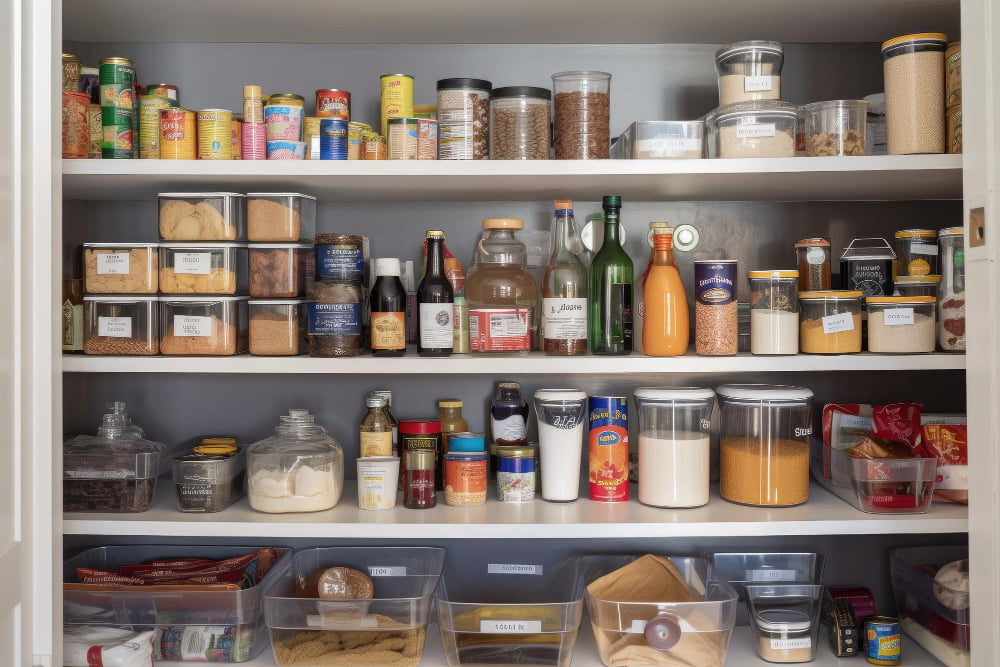
Strategic placement of items can play a critical role in preventing pantry bugs.
– Reserve higher shelves for unopened, long-term stash canned goods or jars. Most pantry bugs find lofty positions difficult to access.
– Frequently used items like cereals, pasta, or rice should be stored in lower, easily accessible shelves. Regular motion of these items can disrupt any pest settling activity.
– Contain loose foods such as grains and flour in airtight containers. The secure setting deters infestation and prevents cross-contamination—especially crucial for bug-prone foodstuffs.
– Segregate pet food from human food. Some pests are more attracted to pet food, thus better placed at a distance to avoid cross-infestations.
– Rotate food items regularly, practicing the First-In, First-Out (FIFO) method. This rotation ensures no food is left idle and unnoticed for pantry pests to infest.
Adopting such mindful organisation can contribute significantly to a pest-free pantry.
Tips for Pest-Proofing Your Pantry
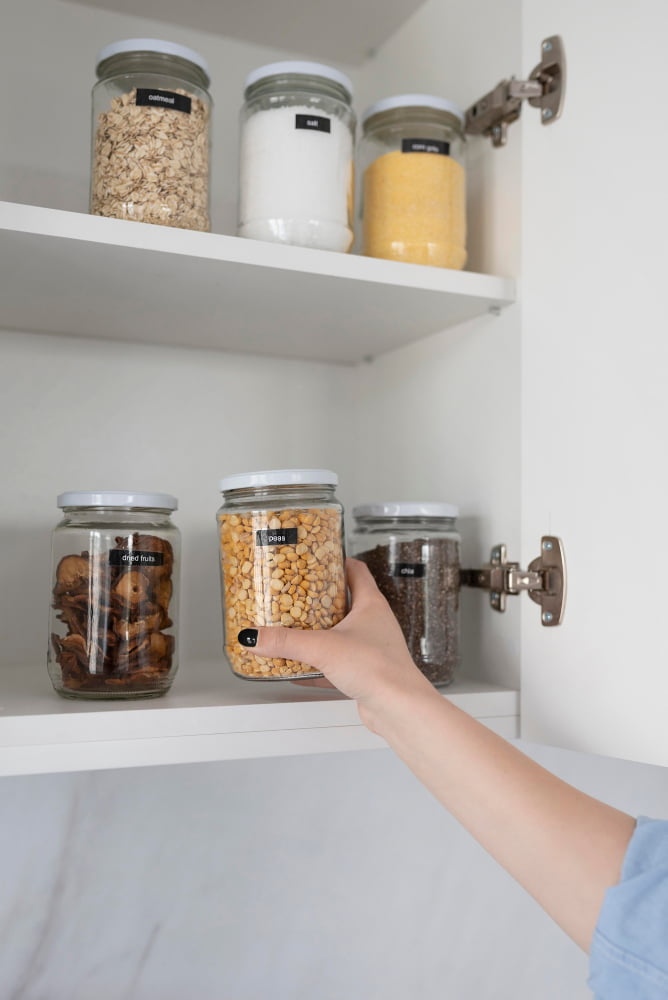
Store foods in airtight containers. Not only will this keep your pantry tidier, but it also makes it more difficult for pests to access your food.
The addition of bay leaves in containers, canisters, and bags of dry goods like flour can deter pests. The scent, which is pleasant to humans, is quite off-putting to bugs.
Clean up spills immediately. Residual sugar, crumbs, or liquids can draw insects into your pantry. Regular and immediate cleanups can significantly reduce the attraction.
Reach out for essential oils such as peppermint, tea tree, and eucalyptus. They have been noted for their deterrent properties. A few drops in a spray bottle of water and spritzing shelves can help keep bugs out.
Consider using pantry moth traps for common pests like the Indian meal moth. These traps use pheromones rather than chemicals to attract pests and can help you monitor for any infestations.
Check for cracked or unsealed doors, walls, and cabinets. Insects can crawl through the smallest of spaces, so ensure your pantry is properly sealed and check for potential entry points.
New grocery items should be checked for signs of infestation like chewed packaging or small holes. Always do this before storing fresh produce in your pantry. A single contaminated package can infest a pantry.
Spotting Common Pests: Indian Meal Moth, Flour Beetles, Weevils
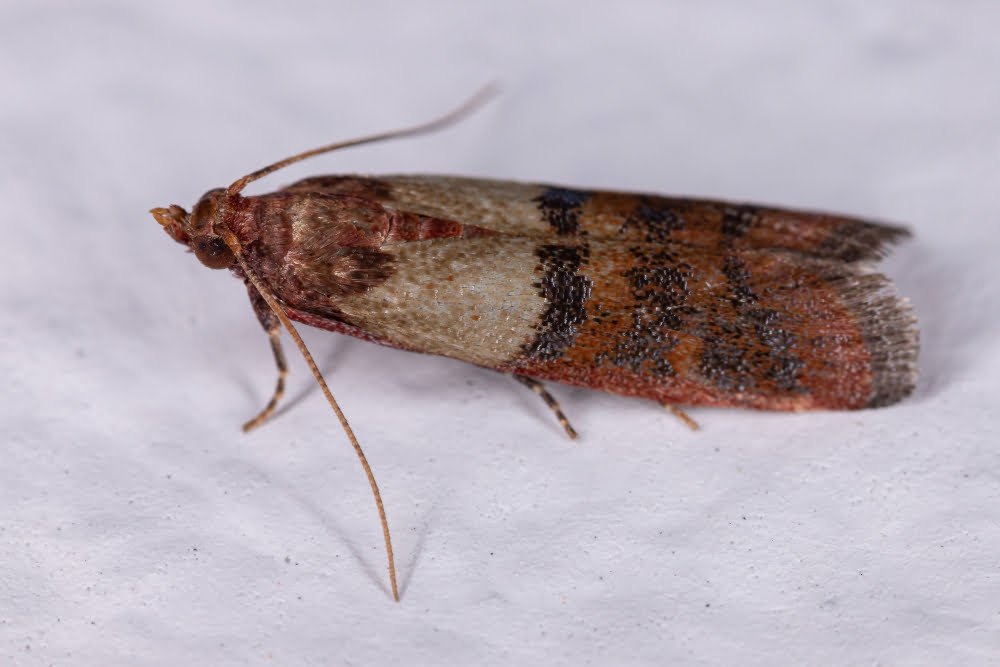
Indian Meal Moths are notorious for their love of dried fruits and grains. They are easy to spot by their wings, which feature a grey top and reddish-brown base. The larvae, a more insidious part of the infestation, feed on your stored goods and leave behind silken webs, a telltale sign of their unwelcome presence.
Flour Beetles come in two main species: the Red and the Confused Flour Beetle. Both are tiny, only 3-4mm long, and reddish-brown in color. They are commonly found in grains and cereals. Look out for fine flour sitting at the bottom of your packages, which suggests beetle activity.
Weevils are distinct in appearance, with their elongated snouts setting them apart from other pests. These beetles lay eggs in various food sources, such as whole grains or seeds. One key sign of weevils is their exit holes on food packets or grains, which newly hatched larvae leave behind.
Preventing Future Infestations of Pantry Bugs
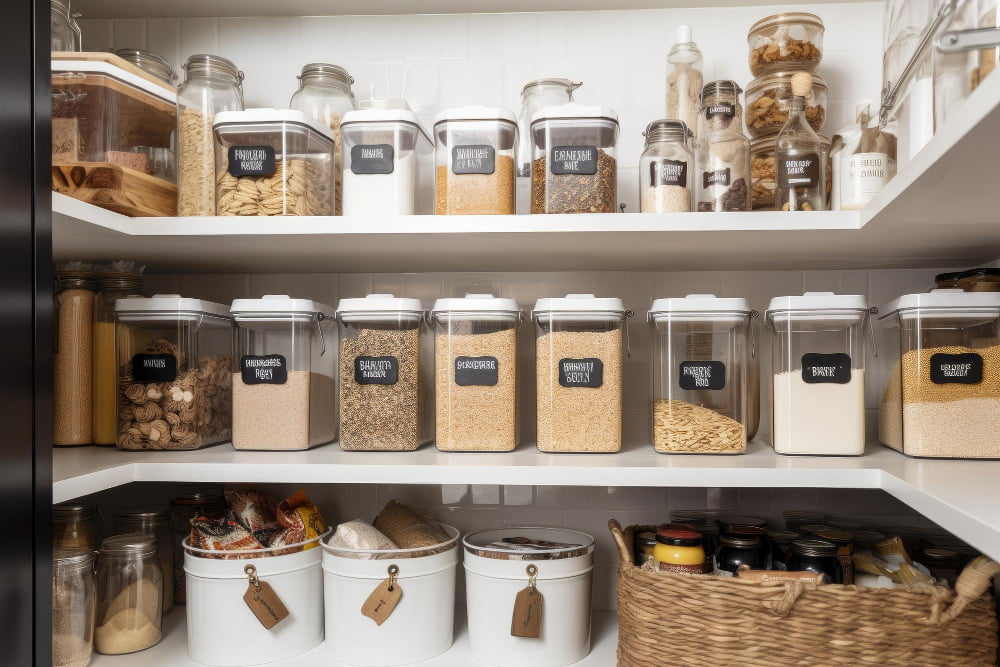
1. Invest in High-Quality Containers: Use airtight, sealed containers for bulk items like flour, cereal, and sugar to secure against pantry bugs.
2. Regular Maintenance Cleaning: Carry out a deep cleaning of your pantry every few months and keep regular cleaning schedules. Remove and replace old shelf liners if necessary.
3. Maintain Food Freshness: Rotate your stock to use older items first and reduce the chance of infestation in ignored packages.
4. Regular Inspection of Groceries: Inspect newly purchased grocery items before storing them in your pantry. Ensure packets are free from any signs of bugs.
5. Use Bay Leaves: Store a few bay leaves in your pantry. The scent often deters various insects, including common pantry pests.
6. Maintain Low Pantry Humidity: Install a dehumidifier if necessary. Bugs are less attracted to dry environments.
7. Seal Pantry Cracks and Crevices: Seal any small openings where bugs could be entering from within the house or outdoors.
Advice On Natural Pest Solutions for Pantry Pests
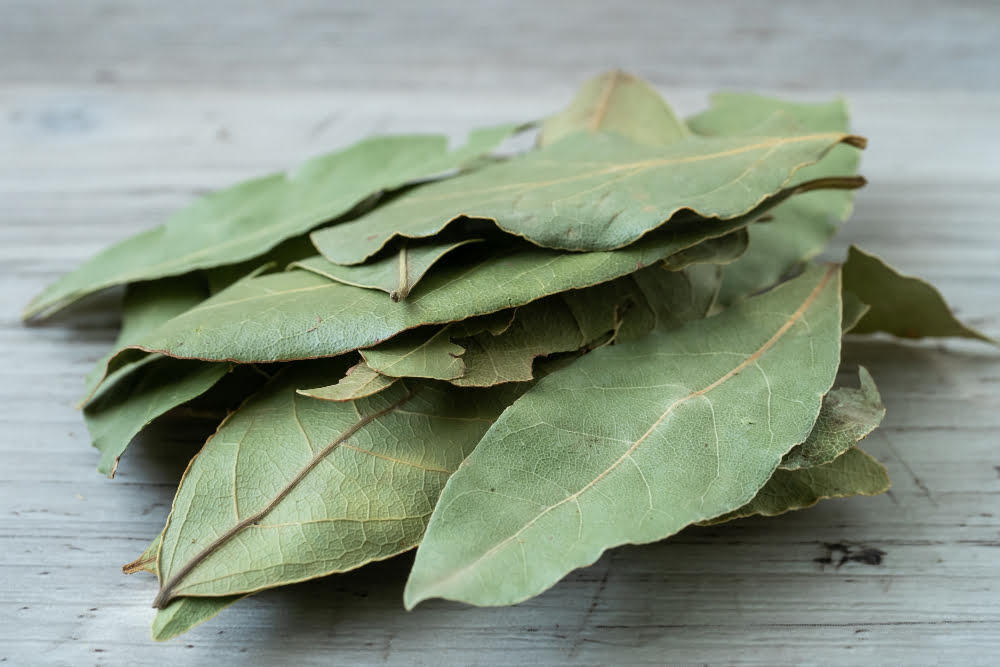
When combatting pantry pests, it is crucial to remember:
- Routine inspections: Regular and thorough check-ups help in early bug detection, thus preventing turning an infestation into a big problem.
- Proper food storage: Store your food items such as grains, flour, and spices in airtight containers, which act as initial barriers to pests.
- Essential oils: Pests are repelled by strong scents. Eucalyptus, peppermint, and lavender oils are effective as natural repellents.
- Bay leaves: Inserting dried bay leaves in stored food containers helps deter pantry pests, as they dislike its scent.
- Cleanliness: Regularly cleaning the pantry keeps pests at bay. Bread crumbs or spills serve as food sources for these pests, hence cleanliness deprives them of sustenance.
- Diatomaceous earth: A natural powder made from tiny fossilized aquatic organisms, safe to use around food and effectively kills insects by drying them out.
Giving attention to these points will create a hostile environment for pests and aid in maintaining a bug-free pantry.
Understanding the Necessity of Removing Pantry Pest Infestations
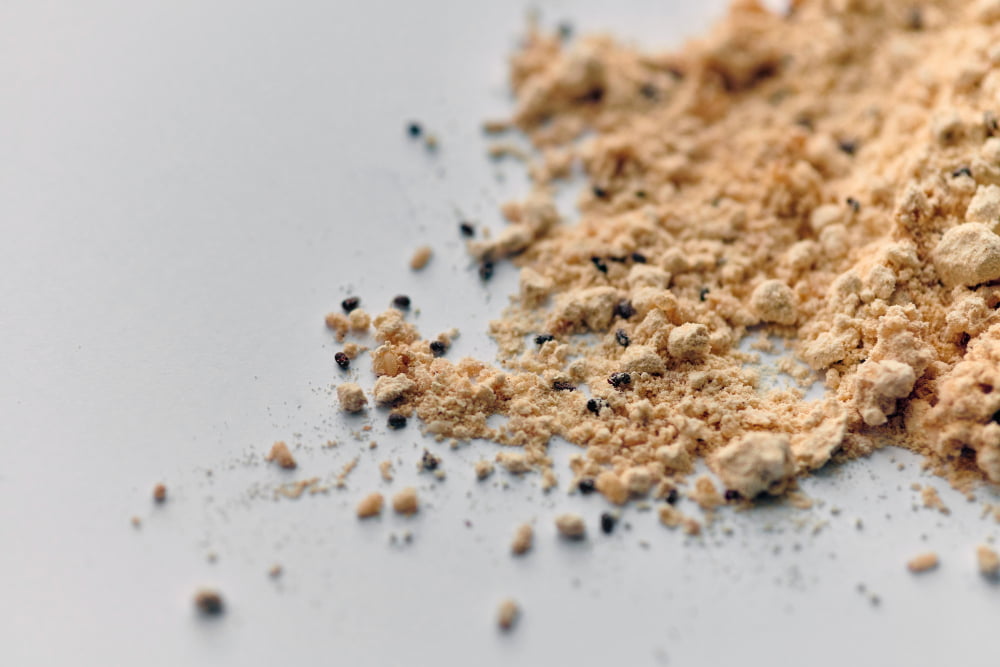
Pantry pests, while small, can lead to significant food wastage by infesting and spoiling stored goods. Additionally, their lifecycle stages – egg, larva, pupa, and adult – create a continuous cycle of infestation if not addressed appropriately. Some pests are also known to introduce harmful bacteria to your food, posing health risks.
Key points:
- Food wastage: Pantry pests can infest a wide range of stored goods, making them unfit for consumption.
- Continuous cycle of infestation: Without intervention, pests go through their lifecycle unimpeded, leading to persistent infestations.
- Potential health risks: Some pests have been identified to harbor harmful bacteria, thereby posing a health risk when they come into contact with food.
FAQ
How do I get rid of little bugs in my pantry?
To get rid of little bugs in your pantry, you should completely empty the pantry, vacuum the shelves, floors and corners, and clean these spaces with soapy water, avoiding the use of bleach, ammonia, or pesticides.
Does vinegar get rid of pantry bugs?
Yes, vinegar can be used to eradicate pantry bugs by wiping down your shelves with it after cleaning them with soapy water.
What can I spray in my pantry for bugs?
For bug infestation, spraying a combination of Novacide Aerosol, Pyrid Aerosol, and Pro-Pest Pantry Moth Traps in your pantry after cleanup can effectively kill the remaining pests and ensure eradication of the entire population.
How do I get rid of pantry bugs in my kitchen?
To eliminate pantry bugs in your kitchen, it’s necessary to remove all food products, then thoroughly clean and vacuum the pantry, focusing on dust, larvae, and bugs, followed by wiping the walls and shelves with wet towels or cloths.
What are some effective home remedies for eliminating pantry bugs?
Effective home remedies for eliminating pantry bugs include maintaining cleanliness, sealing food in airtight containers, using bay leaves, and applying diatomaceous earth in bug-infested areas.
Can essential oils be used to control a pantry bug infestation?
Yes, essential oils like peppermint, eucalyptus, lavender and tea tree oil can be effective in controlling a pantry bug infestation.
How can I prevent pantry bugs from coming back after an infestation?
To prevent pantry bugs from returning after an infestation, ensure regular cleaning of pantry shelves, store food in airtight containers, and monitor for signs of infestation consistently.
Recap:
